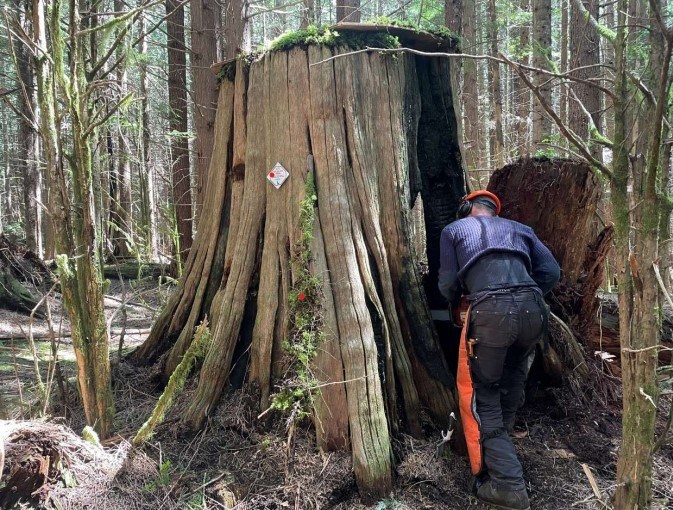Along with a tight housing market for humans, the lower Sunshine Coast is also experiencing a crunch in denning sites for bears.
According to the website of Duncan based Artemis Wildlife Consultants, “the large, old trees that black bears need to survive the wet, cool conditions in coastal BC are often lost during forest harvest operations, sometimes because field staff cannot easily tell which trees are dens”.
Helen Davis, a registered professional biologist with that firm visited our area in late May and working with Elphinstone Logging Focus (ELF) restored four potential denning sites in two days. In addition, she guided an ELF team of six through the process of taking legacy old-growth stumps and making a few alterations to hopefully provide a safe, dry den for mainly female black bears to hibernate within.
Den basics
Transitioning a stump into an inviting potential den site involves a couple of quick steps, according to ELF’s Ross Muirhead, who participated in the local project. Once a suitable stump is located, the top edge is cut down to solid wood, using a chainsaw, and a 1/2 inch sheet of plywood is placed over the opening creating a “cut-to-fit” roof. Then an entrance at the stump base just large enough for a female bear to squeeze through is carved in with the saw. After that bedding material, such as local ferns, is added.
“With the widespread loss of old-growth across the Sunshine Coast, and the province, bears have lost their preferred den sites which are the hollowed out bases of living red and yellow cedars,” Muirhead explained in an email to Coast Reporter.
"We have positioned wildlife webcams in front of each entrance to monitor usage over a 5-6 year time period."
When asked if ELF would consider making the footage from the webcams public, akin to what is done by Grouse Mountain at the home of relocated grizzlies Grinder and Coola, Muirhead noted "If a den gets used by a bear then that footage can be shared from our website and social media."
He cautioned that Davis' research has shown that it takes time for a bear to feel comfortable entering these types of dens. "They seem to know that something is not quite right" he stated noting that at one of Davis' Vancouver Island plots, it took six visits by a bear before the site was put into over-winter use..
A pilot project and more
The initial round of work done locally, which was the fourth B.C. pilot restoration project headed up by Davis, and a report on the process cost ELF approx. $5,000. Muirhead approached the privately-based Coll-Cheng Family Fund and it supported the project.
“The realization that bears need these old structures (hand-logged old-growth stumps) for a secure hibernation period of 4 to 5 months, we (ELF) feel the need to create more restored dens where the right type of stump can be found,” Muirhead stated. He explained that the search for stump-candidates needs to focus on areas where old-growth was hand logged, such as in the Dakota and Rainy watersheds.
“Old-growth trees cut by chainsaws don't work as potential dens because they've been cut off at the base. Whereas, with the legacy stumps that were hand logged, the loggers back in the day (pre-WW2) got above the flare of the base, to reduce cutting time by cutting an insert into the tree to secure a springboard on each side so the fallers could work together sawing way above (5-10 feet) above the base.”
Muirhead said that now that the local team has experience with the scope of "renovating" legacy stumps as potential dens, ”we can do a few more ourselves.”
“It doesn't cost that much if volunteers get involved.”
The full report on the project can be viewed online..



